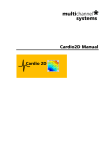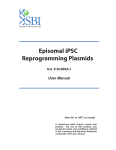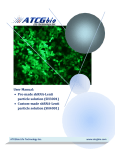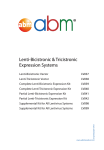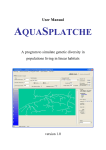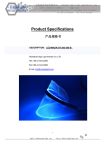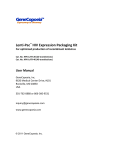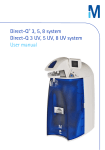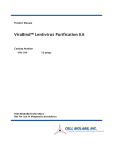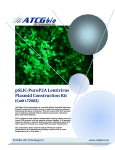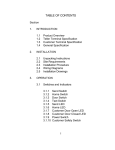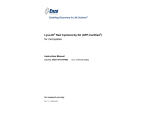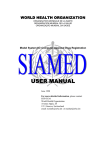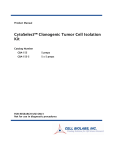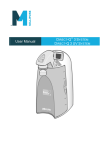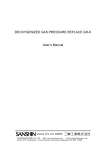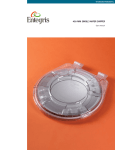Download user manual pdf - ATCGbio Life Technology
Transcript
Lentivirus Production Kit (Cat# LT1001) [ATCGbio Life Technology provides the kit could let user to produce high titer lentivirus in 48 hours and ready to infect in the scale and time users can choose. The procedure performs in small scale cell culture with high titer virus production system, which in turn to save physical and financial expenditures. Purified virus can be injectable to small animals to infect local tissues. Compatible for both 2nd and 3rd generation of virus constructs.] ATCGbio Life Technology Inc. www.atcgbio.com Lentivirus Production Kit (LT1001) ATCGbio Life Technology Inc. Contents Overview .................................................................................................... 2 Kit Features ............................................................................................... 2 Kit Components and Storage Conditions ................................................. 2 User-provided Materials and Equipment .................................................. 3 Detailed Protocols ..................................................................................... 3 Transduction Protocol .................................................................................................... 5 Result Examples............................................................................................................... 5 Protocol to Make Permanent Expression Cell Lines ............................... 6 References ................................................................................................ 6 Contact Information .................................................................................. 6 FOR RESEARCH USE ONLY Not for use in clinical or diagnosis purpose Important Notice: Laboratory workers handling pathogenic lentiviruses, recombinant lentiviral vectors, naturally or experimentally infected laboratory animals, or clinical specimens potentially infected with lentiviruses. Diagnostic specimens that contain human blood, body fluids or tissues can be handled and manipulated at the BSL-2 level. BSL-2 is also appropriate for generating and using lentiviral vectors, and handling animals and animal tissues, blood, body fluids and cell lines that are infected with lentivirus vectors. When you practice recombinant lentiviral vectors, please following the requirements outlined in http://oba.od.nih.gov/rdna_rac/rac_guidance_lentivirus.html and CDC Biosafety in Microbiological and Biomedical Laboratories, 5th edition, the NIH Guidelines for Research Involving Recombinant DNA Molecules, latest edition. www.atcgbio.com 1 Lentivirus Production Kit (LT1001) ATCGbio Life Technology Inc. Lentivirus production kit User Manual Overview This kit lets user to produce high titer lentivirus ready to infect in scale and time users can choose. The kit provides helper plasmids mixture, lentivirus production medium and viral purification reagents. By using this kit along with lentivirus vector plasmid (2nd. or 3rd. generation) user provides, lentivirus is ready to use in 48 hours. User can create gene of interest expressing lentivirus vector plasmid by using our lentivirus vector plasmid in just one day by PCR. We also provide pre-made and custom-made shRNA lentivirus plasmids. In 6-well plate cell culture, users can get 3ml crude lentivirus containing medium per well with 0.5 ~ 9 x107 TU/ml viral titer depending vector size. This crude virus can be used directly to infect target cells if the medium (DMEM base) is compatible and the cells are ready. In case that medium is not compatible or if users want to store the virus longer time (more than 4 days, usually crude virus keeps sufficient titer in 3 days at 4 °C), the kit also provides purification reagents which allows to produce concentrated purified virus with high stability at -80oC storage. With this unique configuration and optimal production reagents, the user can use lentivirus as flexible as adenovirus in both primary and transformed cell lines. The provided kit is enough to create three 6-well plates (48 ml crude virus). Kit Features 1. Small scale (6 well plate format), high titer (up to 0.9 x 108 TU/ml) virus production system*, which in turn to save physical and financial expenditures. 2. The provided production medium does not contain chemicals used to add lentivirus production such as sodium butyrate, caffeine, or chloroquine. So, lentivirus in this medium can be directly used for most of applications. 3. Reagents for purification and long-term storage are included. 4. The kit produces high quality virus, meaning that higher percentage of virus is functional, resulting in higher transduction rate. Quality of virus is a more important and critical factor than just count virus number (assessed by p24 antigen, RT-PCR). 5. Purified virus can be injectable to small animals to infect local tissues. 6. Compatible for both 2nd and 3rd generation of virus constructs. 7. The kit includes GFP expressing lentivirus plasmid as positive control. * This is typical results with our lentivirus vector. If using other lentivirus vector, the results may vary based on vector construct design. Kit Components and Storage Conditions Catalog LT1001-01 LT1001-02 LT1001-03 Items Lentivirus Production Medium (55 ml in 60 ml bottle): add 1.2 ml FBS before use. 4 °C Helper Plasmids Mixture (0.2 ml in 0.5 ml tube): 4 °C Production Helper Solution (0.2 or 0.5 ml in 0.5 ml tube): 4 °C www.atcgbio.com 2 Lentivirus Production Kit (LT1001) LT1001-04 LT1001-05 LT1001-06 LT1001-07 ATCGbio Life Technology Inc. Plate Coating Solution (2 ml in 2 ml tube ): 4 °C. Lentivirus Purification Solution (20 ml in 30 ml bottle): 4 °C Lentivirus Storage Solution (2 ml in 2 ml tube): 4 °C GFP expressing lentivirus plasmid, 1 µg in 20 µl TE (ampicillin resistance): 4 °C User-provided Materials and Equipment 1. 293T cells (from ATCC, we do not recommend Invitrogen 293FT cells which produce about half amount of viruses). 2. Routine culture medium for 293T cells (DMEM high glucose + 10% FBS + antibiotics). 3. 6-well cell culture plate (any companies’ product). 4. Centrifuge to be capable to reach 1500xg at 4oC (for purification) 5. FBS: ordinal FBS for 293T culture (heat-treatment is not necessary) 6. Lentivirus plasmid: 3 µg lentivirus plasmid will be required for one 6-well plate (0.5 µg per well). The plasmid should be transfection grade* suspended in TE buffer and the concentration should be more than 50ng/µl. Once purified, store at 4oC. 40-50ml E.coli. culture should produce enough amount of plasmid for more than 10 preparations. Do not use spin Mini-prep purified plasmid which contains endotoxin. 7. 0.22 µm PDVF syringe membrane such as Millipore Millex Filter units 8. Trypsin/EDTA * The purification column is supplied by Qiagen (cat#12123), Clontech (cat#740571), or Eppendorf, etc. Detailed Protocols Following are the protocols to produce 18 ml crude virus in one 6-well plate. The scale of production can be reduced to 1 well of 6-well plate (3 ml virus) or 1 well of 12-well plate (1.5 ml virus) by reducing the amount of reagents proportionally. The provided reagents enough for three times production in this scale 1. Culture 293T cells with DMEM high glucose medium containing 10% FBS in a 100 mm dish. Split cells when it reaches 90-100% confluence. Do not make the cells completely confluent for more than 2 days. 2. Lentivirus production medium: add 1.2 ml of FBS to the medium provided (about 55 ml) before use and keep it at 4°C. This medium should be used in 6 months. Then, follow the A, B and C steps: A. First day We recommend starting procedures around 10am to go home around 5pm. 293T cells should be more than 90% confluent and lentivirus plasmid should be ready. Take out Trypsin/EDTA, DEME+10%FBS medium (high glucose) and lentivirus production www.atcgbio.com 3 Lentivirus Production Kit (LT1001) ATCGbio Life Technology Inc. medium from 4oC and warm up to room temperature. 1. Treat a 6-well plate with coating solution. Take 0.6 ml coating solution with 1ml pipette, dispense into one well, take it up and dispense into another well, repeat. Make sure the coating solution spreads evenly on the bottom of wells. It is not necessary to dry 2. Gently wash 293T cells (cultured in 100mm dish) with 5 ml PBS three times. 3. Add 8 drops or more of Trypsin/EDTA solution. Wait 3-4 min till the cells float. Take 13-15 ml of DMEM+10%FBS medium (use 13 ml if the cells are 90-95% confluent and 15 ml if over-confluent), dispense into the dish, gently up-and-down 3 times. Dispense 12ml medium+cells to the coating treated 6-well plate (2 ml each well), and put it into CO2 incubator at 37oC. Rest of the cells will be plated in the 100 mm dish for future use. It takes about 2 hours for the cells to attach on the plate. 4. After 2 hours, start to prepare viral production mixture. Take 600 µl PBS to a 15 ml sterile conical tube. Add 3 µg lentivirus plasmid (user provided or purchased our lentivirus plasmid), 60 µl Helper-plasmids mixture, and 60 µl Production-helper solution. Vortex briefly and wait 10 minutes. Add 6 ml DMEM+10% FBS (Note: this is not lentivirus production medium Cat#LT1001-01) 5. Remove the medium from cultured cell and gently add 1ml DMEM medium of step 4 which contains viral production mixture in each well. (Note: the solution must be added by touching pipet tip onto the well wall with slow ejection. Do not drop or eject the solution directly to the cells). 6. Put it back to CO2 incubator. 7. After 3 - 4 hours, change the medium to 2 ml lentivirus production medium in each well. 8. Incubate in CO2 incubator for overnight. The cells start producing lentivirus in the medium. B. Second day Following procedures should be done in the morning. 1. Equilibrate lentivirus production medium to room temperature. 2. Gently add lentivirus production medium 1 ml to each well by pipet out slowly onto the well wall. (Note: do not change medium, just add medium. Total amount of media will be 3 ml.) 3. Put the plate back to CO2 incubator. C. Third day Following procedure should be done in the afternoon (48 hours after adding lentivirus production medium). 1. Collect the medium which contains lentivirus. Kill the remaining cells with 10% bleach. 2. Centrifuge at low speed (1000 rpm or 200×g) for 5 min to precipitate any cell and debris. 3. Filter crude viral medium through 0.22 µm PDVF membrane into 50 ml sterile conical tube. www.atcgbio.com 4 Lentivirus Production Kit (LT1001) ATCGbio Life Technology Inc. 4. Add one part of Lentivirus Purification Solution to every 3 parts of virus solution in volume. (e.g. 6 ml to 18 ml medium) Lentivirus Purification solution: filtered crude virus = 1: 3 Mix well by inverting the tube. 6. Users have two choices at this moment. A) Use the crude virus medium containing Purification solution directly and freeze the rest in aliquots. To infect the cells growing the medium compatible with DMEM, up to 1/3 of crude virus medium containing Purification solution can be added (e.g. add up to 1 ml medium to 2 ml growth medium). The Purification solution stabilizes lentivirus and even increases infection efficiency and in many cases eliminates polybrene usage. Users can keep the lentivirus solution with Purification solution up to 3 days at 4 °C and rest of them at – 80 °C. B) Purify the virus and add storage solution then aliquot out. If the growth medium is not compatible DMEM, virus should be purified and stored accordingly. Frist, leave the crude virus solution containing Purification solution at 4 °C for overnight. Next day, Centrifuge at 1500 ×g for 30 minutes at 4 °C. Slowly decant the supernatant and keep the capped tube inverted for 5 minutes. Carefully open and re-suspend the pellet with 600 µl lentivirus storage solution. Incubate the tube at 37 °C for 5 minutes till the solution becomes almost clear. After pipetting up-down a few times, aliquot out appropriately and keep the concentrated virus in -80°C. Transduction Protocol Addition of polybrene at 2-10 µg/ml at final concentration results in 2-fold increases in transduction efficiency. However, since the virus quality is very high, in most of the case, polybrene is not necessary to use. Purified virus can be injectable to small animals to infect local tissues (see Fig.C in vivo transduction below). Result Examples Fig.A and Fig.B: GFP expressing lentivirus was created with two different medium Fig.A Conventional DMEM+10% FBS www.atcgbio.com Fig.B Our Lentivirus Production Medium + 2% FBS 5 Lentivirus Production Kit (LT1001) ATCGbio Life Technology Inc. 50 µl of 3 ml crude lentivirus with medium was directly used to infect 293T cells (without polybrene) grown in a separate 6 well plate. 48 hours later the expression of GFP was assessed. Fig.C In vivo transduction sample 50 µl of purified lentivirus with our kit was injected into a mouse subcutaneous adipose tissue (without polybrene). After three days, the tissue was harvested and observed under fluorescence microscope and bright field. Protocol to Make Permanent Expression Cell Lines To make permanent expression cell lines, it may be sufficient to make lentivirus in just one well of 6well plate. To make lentivirus with our shRNA lentivirus plasmid, typically, 300 µl of crude medium is usually sufficient to make gene knock-down cell line cultured in one 6-well plate (This may be variable since lentivirus titer is strongly influenced by lentivirus constructs and insert size). So that, 3 ml lentivirus-containing medium may be sufficient for many situations. User should try with our control lentivirus plasmid comes with kit which express GFP, then test whether your target cells are easily infectable or not. To do that, just simply scale down by cutting all reagents to 1/6. If required, purification step can be done, too. References 1. Y. Ido, et al. PLoS ONE, 2012 Apr 07(4): e35092 2. Lan F, et al. J Biol Chem. 2008 Oct 10;283(41):27628-35 Contact Information Laboratory: 3938 North Fraser Way Burnaby, BC V5J 5H6 Canada Tel: +01.778.321.9336 (order only) Fax: +01.604.415.9795 (order only) Email: [email protected] www.atcgbio.com 6 Lentivirus Production Kit (LT1001) ATCGbio Life Technology Inc. Business Hours: Monday to Friday 9am-5pm (GMT -8:00 Pacific US) Ordering information: All of your orders are available on line at https://atcgbio.com. Technical Support: Please send email to us ([email protected]). Or, click Contact Us to fill the form for enquires. We will response within 1-2 business days. www.atcgbio.com 7








